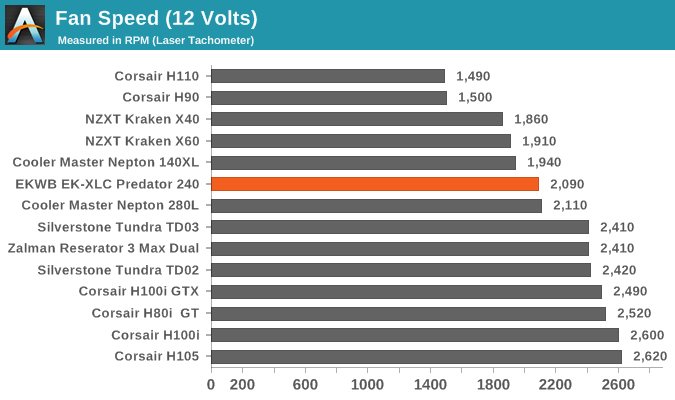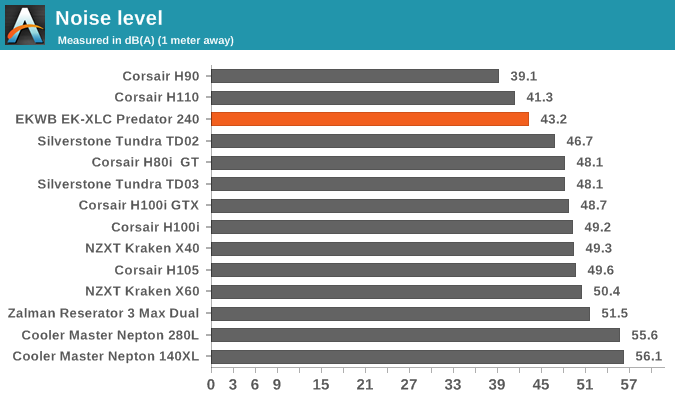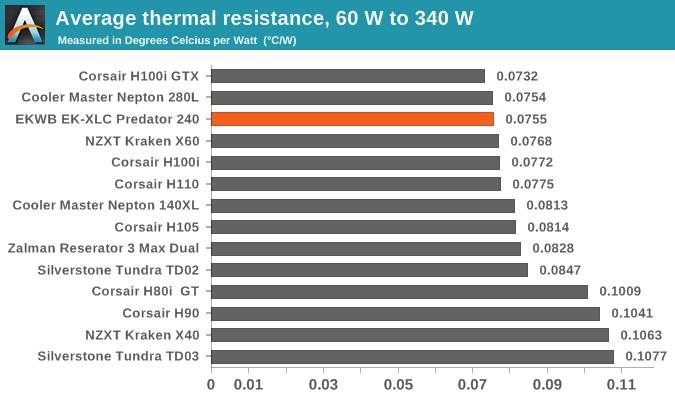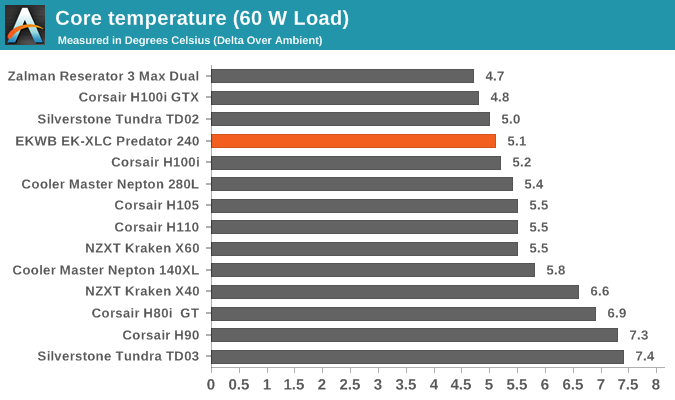The EKWB EK-XLC Predator 240 Liquid Cooler Review
by E. Fylladitakis on December 15, 2015 9:00 AM EST- Posted in
- Cases/Cooling/PSUs
- AIO
- Water Cooling
- Liquid Cooling
- EKWB
Testing results, maximum fan speed (12 Volts)




| Core Temperature, Constant Thermal Load (Low Fan Speed) |
The EKWB EK-XLC Predator 240 is displaying excellent thermal performance in relation to its noise level output, especially under heavy loads. Its average thermal resistance of 0.0752 °C/W matches the performance of the Cooler Master Nepton 280L, a larger and much louder AIO cooler. From all of the AIO coolers that we have ever tested, only Corsair's H100i GTX manages to outperform the EK-XLC Predator 240, by just 0.002 °C/W at the expense of 5.5 dB(A).
As it can be seen from the above charts, the EK-XLC Predator 240 is one of the quietest dual fan AIO liquid coolers that we have tested to this date. At 43.2dB(A), the fans are clearly audible, but they are not overly loud and should not distract the user from gaming or similar tasks. Considering that the Vardar fans are using dual ball bearings, these can be very reliable but it is also a relatively noisy type of bearing - it is interesting that the noise figures are this low.
Furthermore, what the charts fail to communicate is the pump's high pitch whining noise, which adds little to the dB(A) but is uncomfortable. The high pitch noise coming from liquid pumps is a very common problem for AIO coolers. But actually this may be the greatest advantage of the EK-XLC Predator 240, as the pump is imperceptible with the noise of the fans overshadowing it entirely.










36 Comments
View All Comments
shaolin95 - Thursday, December 17, 2015 - link
er no...its the top Air Cooler but no it does not "blow away almost all of these coolers" plus not everyone likes such huge thing on your build.I used to my tastes got refined and no longer like that huge chunk of metal there not to mention that its harder to clean between fins compared to a radiator.
stren - Thursday, December 17, 2015 - link
Yes using a lab grade setup like that is great for more accurate system measurements. It's damn hard to test radiators well after all - ask my buddy fast_fate about that. *But* a good amount of performance can be gained or lost from bow of the CPU block and how well it matches the CPU's IHS. One thing you failed to mention in your methodology is how the block was mounted to the heater plate. Which TIM was used? How many mounts did you do? Mounts can produce quite variable results. Typically a 1C variance might be seen in mounting one block to one CPU in one orientation. Different CPUs and orientations will produce a wider spread still. In addition measuring ambient air in is extremely hard to do well even if your sensors are world class. How many sensors do you use, how spread out are they, how far from the fans are they? Is there an intake manifold? Is the manifold restrictive? Is there any other airflow in the room? How much does the ambient change? What's the error in the system? How long do you log for, how many runs do you average etc etc?If you were to test CPU water blocks independently on a such a setup the results would be very different to those testing on a real motherboard/CPU. This is particularly true when a small difference in mount height can change mounting pressure and hence TIM thickness. Some block mounts bottom out rather than relying on a set torque to tighten and hence making your own mount will mean a difference in mounting pressure than a real motherboard/CPU combo.
In essence while you're testing *part* of the system very accurately, you're not testing the whole system accurately. While I applaud the effort to measure AIO's well, I think you'd do well to drop the lower power runs where the margin of error is > than the difference in the data in order to save time and also test with a CPU to try and see some impact of the mount on a real world system. Of course the latter can be frustrating to get the accuracy required. Taking data on ten water blocks accurately on one CPU can take me a month. So I can understand why you'd want to limit the variables, but it might be wise to mention that by limiting the variables in order to be more accurate you are also making the test less accurate by being a simulation of the real thing.
r4serei - Friday, December 18, 2015 - link
i'm lovin my 240. i've already expanded onto it with a block for my gpu and another rad. was surprisingly simple.r4serei - Wednesday, January 13, 2016 - link
EK has issued a recall for all revision 1.0 Predators due to a faulty O-ring. It's been corrected on revision 1.1 which has been released as of Jan 4th.alexrw - Saturday, January 30, 2016 - link
> the pressure triples for every increase of 3 dB(A)err, doubles ... actually almost doubles (the exact value when it exactly doubles is not 3dB but 10*log10(2)=3.0102999 dB, or conversely the ratio for exactly 3dB is not 2 but 10^(3/10)=1.99526)
file2man - Sunday, October 30, 2016 - link
I recently purchased the ekwb extreme 360 kit- it has a separate pump, reservoir, clear tubing for somwhere around $350 at microcenter. the pump is not variable speed like most other bought outside of kits and can only vary its speed by a fan controller. Im new at liquid cooling but I suspect hard tubing will in the longer term attract less sediment and is much preferred . Have not reached ek yet but not sure if I can use the 360 extreme kit fittings 13/10mm g1/4 for hard tubing literature says soft tubing is 9.5mm/12.7mm (3/8/1/2 inch). Any help is appreciated since is no way to email ek